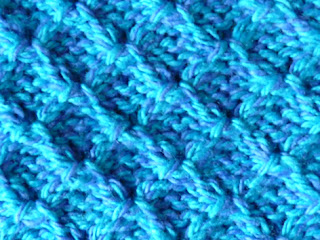Variations of tuck , slip stitch and
fair-isle using Knitmaster/Silver Reed standard punchcard no 3
Punchcard no 3 has a 4 stitch horizontal pattern and an 8 row
vertical pattern repeat. The pattern repeat is broken up into two distinct areas and has a needle selection change at row 5.
The squares that are punched out KNIT the stitches and
the squares that are left blank TUCK or SLIP the stitches.
It is really important to be able to analyse punchcards (or needle selections if working with a none automatic machine) in order to get the maximum benefits from working at depth with a single punchcard.
Tuck stitch worked in plain colour, face and reverse sides
of the fabric
Slip stitch worked in plain colour - face and reverse sides of the fabric

The following 2 colour samples
were knitted with yarn changing at the RIGHT of the bed, and the punchcard unlocked
at ‘1’ when the carriage is on the RIGHT after the ‘set’ row is worked from
LEFT TO RIGHT.
Tuck stitch worked in two colours, two row stripes - face and reverse.
Slip stitch worked in two colours, two row stripes – face
and reverse
The sample below was knitted
with yarn changing at the RIGHT of the bed, and the punchcard unlocked at ‘1’ when
the carriage is on the LEFT after the ‘set’ row is worked from RIGHT TO LEFT.
Tuck stitch worked in two colours, two row stripes face and
reverse.
Notice how the lilac stitch pattern is more ‘lozenge’ shaped
than in the earlier tuck sample. This is caused by starting on a single row of
colour (as described above) and then working the two row stripes over an even needle
selection pattern. This staggers the two rows of main colour (blue) across the
needle selection change.
Fair-isle worked with the card rotating normally and with
the card locked after each repeat, and 2 rows of plain knit in the ‘background’
colour worked in before unlocking the card and resuming fair-isle settings.
Try variations using 3 and 4 colours, locking the
card, interspersing plain knit rows, lace holes, ladders, ripples etc., with other standard and your own card designs.











No comments:
Post a Comment